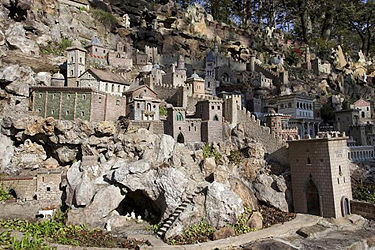Ave Maria Grotto
Ave Maria Grotto is a landscaped, 4-acre park in an old quarry on the grounds of St Bernard Abbey in Cullman. The garden serves as the setting for 125 miniature reproductions of some famous religious structures from around the world. The stone and concrete models were the life's work of Brother Joseph Zoettl, a Benedictine monk of St Bernard's, who devoted some 50 years to the project. They incorporate discarded building supplies, bricks, marbles, tiles, pipes, sea shells, marbles, plastic animals, costume jewelry, toilet bowl floats and cold cream jars.
Born in 1878 in the Kingdom of Bavaria, Brother Joseph was maimed in an accident that gave him a hunchback. He immigrated to the United States as a teenager, settling in northern Alabama. Soon afterward he began studying at the newly founded Benedictine monastery of St Bernard’s, where he took his vows in 1897. He ran the monastery’s power plant and was, even by a monk's standards, a withdrawn, quiet man. Until his death in 1961, Brother Joseph rarely left Alabama.

The display, which opened to the public on May 14, 1934, is strung out along a forested trail that winds down past several building clusters built into a steep hillside which had been terraced by previous quarrying operations.
Roman Catholic cathedrals and monasteries predominate — notably St Peter's Basilica in Rome, the Monte Casino Abbey and the Sanctuary of Our Lady of Lourdes — along with an entire hillside encrusted with scenes from ancient Jerusalem. A central artificial cave constitutes the Ave Maria Grotto proper, with pretend-stalactite-encrusted ceiling and statues of the Virgin Mary and assorted monks and nuns. Also displayed are the several Spanish missions, the Leaning Tower of Pisa, the Great Wall of China, a few German castles, South African shrines, and fanciful structures such as "Hansel and Gretel's Temple of the Fairies". Zoettl even built a replica of the St Bernard Abbey power station, where he had worked shoveling coal. After his death in 1961, fellow monk Leo Schwaiger continued his work as a mason, repairing the existing miniatures and adding a few new ones.
Near the beginning of the path stands an imagined Tower of Babel, recalling the vainglorious attempt of humans to build a tower to the heavens. Close to the end, a Tower of Thanks expresses Brother Joseph’s gratitude for the support he received throughout the years building his sculptures.
Zoettl worked largely from postcard views. Though executed in great detail, the scale of the edifices is often distorted, with towers and buttresses too large or small, as onsite literature acknowledges. The grotto was listed on the National Register of Historic Places in 1984. During its 75th anniversary in 2009 the entrance and gift shop was greatly enlarged and modernized to include a small theater for an introductory video presentation and meeting space for groups. In addition, a life-size bronze statue of Zoettl was commissioned from Ira Chaffin. It was installed facing the Grotto from a grassy terrace below.
In 2021 artists Ben South and Donna Drake began cleaning out and restoring Zoettl's former workshop space so that it could be seen by visitors, with space for artists to work on new creations which could be sold at the gift shop.
References
- Risen, Clay (August 14, 2002) "Joseph Zoettl’s Grotto" The Morning News
- Beal, Timothy K. (2006) Roadside Religion: In Search of the Sacred, the Strange, and the Substance of Faith. Boston, Massachusetts: Beacon Press ISBN 9780807010631
- Ave Maria Grotto in Cullman, Alabama - SouthernLiving.com Blog - Tales from the Road. Tricks to Great Treats - SouthernLiving.com
- "Ave Maria Grotto" (November 11, 2008) Wikipedia - accessed December 3, 2008
- Garrison, Greg (October 18, 2009) "Cullman, Alabama's Ave Maria Grotto to dedicate statue of creator." The Birmingham News
- Mann, W. c. (April 24, 2021) "One man’s passion: Bremen and Cullman artists reopening Ave Maria Grotto builder’s workshop" Cullman Tribune
External links
- Ave Maria Grotto website
